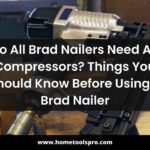Plasma Cutter is a high-powered cutting tool that can take on a variety of materials. These versatile tools use a stream of ionized gas or air to easily cut through metal, wood, plastic, and other materials.
If you’re in the market for a plasma cutter, you may be wondering whether or not you need an air compressor to go along with it.
If you have a plasma cutter that uses compressed air to cut, you will need an air compressor.
In this article, we are going to talk about the basics of a plasma cutter and what type of plasma cutter is best to use with all your metal cutting needs.
Also, an in-depth discussion about the different power sources that plasma cutter uses with their advantages and disadvantages. Ultimately you will be more confident in choosing the right plasma cutter that suits your needs.
What are the Components & Processes of a Plasma Cutter?
- Power Source: The power source provides the electrical energy necessary to create the plasma arc.
- Plasma Torch: The plasma torch houses the electrode and nozzle and is the device through which the plasma arc is created and directed.
- Electrode: The electrode is a conductive metal rod that protrudes from the plasma torch and makes contact with the workpiece.
- Nozzle: The nozzle is a small copper cone located at the tip of the plasma torch. It helps to focus and direct the plasma arc.
- Shield Cup: The shield cup is a metal cup that surrounds the electrode and nozzle. It helps to protect them from arcing and damage.
In order to create the plasma arc, the power source must provide enough electrical energy to ionize the gas within the plasma torch.
This process begins with the electrode, which protrudes from the plasma torch and makes contact with the workpiece.
When the electrical current flows through the electrode, it heats up the gas within the torch, causing it to ionize.
The ions are then drawn towards the nozzle, where they are focused into a small, intense plasma arc. The shield cup helps to protect the electrode and nozzle from damage by surrounding them with a metal cup.
The types of Plasma Cutters based on the Power Source
Air Powered Plasma Cutter:
Air powered plasma cutters work by using a high-pressure air stream to ionize the gas and create plasma. The resulting plasma is then used to cut through the material.
Air powered plasma cutters are often used for cutting thicker materials, as they can generate higher pressure streams of air.
This allows for more precision when cutting thick materials. Plasma cutters are also used in welding applications, as they can provide a clean and precise way to weld two pieces of metal together.
Gas Powered Plasma Cutter:
A gas-powered plasma cutter is a cutting tool that uses a stream of ionized gas to cut through metal. The gas is usually argon or hydrogen, and the plasma is created by an electric arc.
Plasma cutters are used in a variety of applications, from welding to production line cutting. Plasma cutters have several advantages over other cutting tools, such as abrasive wheels or oxy-fuel torches.
Plasma cutters can cut through thicker pieces of metal more quickly, and they generate less heat, so there is less risk of warping the metal.
What to Look for when purchasing a Plasma Cutter?
When looking to purchase a plasma cutter, there are a few key factors you will want to keep in mind.
By doing your research and knowing what to look for ahead of time, you can be sure to find the best possible machine for your needs.
First and foremost, you’ll want to consider the power output of the machine. Plasma cutters are available in a range of different sizes and power outputs, so it’s important to choose one that is powerful enough for your needs.
If you plan on cutting thicker materials or working with tougher metals, you’ll need a more powerful machine.
Another thing to keep in mind is the duty cycle of the machine. The duty cycle is the amount of time the machine can operate continuously before it needs to be rested.
If you plan on using the machine for extended periods of time, you’ll need one with a higher duty cycle.
Finally, you’ll want to consider the price of the machine. Plasma cutters can vary widely in price, so it’s important to find one that fits your budget.
By doing your research and knowing what to look for, you can be sure to find the best possible machine for your needs.
Air Powered Plasma Cutter Vs Gas Powered Plasma Cutter: The Advantages & Disadvantages
You need to consider a few things before purchasing a plasma cutter. One of the most important factors is the power source.
Plasma cutters can either be gas or air powered. There are advantages and disadvantages to both power sources.
Air powered plasma cutters are usually less expensive than gas-powered models. They are also lighter and more portable. However, air powered plasma cutters require a constant air supply. This can be not easy to maintain if you’re not near an air compressor.
Gas powered plasma cutters are more expensive than air powered models. But they offer some benefits that air powered models don’t have.
For example, gas-powered plasma cutters can operate for longer periods of time without needing an external air supply. This makes them ideal for use in industrial settings.
When deciding which power source is right for you, it’s important to consider the advantages and disadvantages of each type. Gas powered plasma cutters are more expensive but offer more benefits.
Air powered plasma cutters are less expensive but require a constant air supply. Consider your needs before making a purchase to ensure you get the right model for your application.
How to use an Air Powered Plasma Cutter?
To use an air powered plasma cutter, first make sure you have the correct equipment. You will need an air compressor, an air hose, and a plasma cutter.
Next, connect the air compressor to the plasma cutter. Then, turn on the air compressor and open the valve. Now, hold the tip of the plasma cutter against the metal you want to cut. Press the trigger to start the flow of ionized gas.
Move the tip of the plasma cutter along the line you want to cut. The stream of ionized gas will cut through the metal.
When you’re finished cutting, release the trigger and turn off the air compressor. Disconnect the air hose from the plasma cutter.
Now you know how to use an air powered plasma cutter. With this tool, you can easily cut through metal for a variety of applications.
Visual Explanations: https://www.youtube.com/watch?v=3PVYbyI5xIo
What can go wrong with Air Powered Plasma Cutters?
A few things can go wrong with air-powered plasma cutters, but fortunately, most of them are easily avoidable with proper care and maintenance.
One of the most common issues is poor air quality. If the air that your cutter is using is not clean and dry, it can cause all sorts of problems.
The most obvious is that the cutting quality will suffer, but it can also lead to premature wear on the cutter components.
Another potential issue is using an improper electrode tip. If the tip is too small, it can cause arcing and premature wear on the tip.
Conversely, if the tip is too large, it can cause the plasma arc to be less focused and result in poorer cutting performance.
Finally, if the cutter is not properly grounded, it can cause all sorts of problems, including electrical shocks and damage to the cutter. Always make sure that the cutter is properly grounded before using it.
By following these simple tips, you can avoid the most common issues with air-powered plasma cutters. If you do experience any problems, make sure to consult your cutter’s manual or contact the manufacturer for assistance.
How to use a Gas Powered Plasma Cutter?
If you’re looking for an efficient and powerful way to cut through metal, a gas-powered plasma cutter is a tool for the job.
Plasma cutters use an electrically charged gas to create a high-velocity jet of hot plasma that can quickly and easily cut through metal.
Using a gas-powered plasma cutter is relatively simple, but there are a few things you need to know before you get started. Here’s a quick guide on how to use a gas-powered plasma cutter.
Choose the right gas. The most common gases used in plasma cutting are oxygen, nitrogen, and argon. Each gas has its advantages and disadvantages, so choosing the right one for your project is important.
Set the gas pressure. The gas pressure should be set according to the metal you’re cutting thickness. Consult the owner’s manual for your plasma cutter if you’re not sure.
Adjust the current. The current can be adjusted to suit the thickness of the metal you’re cutting. Again, consult the owner’s manual for your specific model if you’re unsure.
Place the tip of the cutter on the metal. For best results, try to keep a steady hand and move the tip along in a smooth, even motion.
Let the cutter do its job. Don’t apply too much pressure. The cutter will do all the work. Just guide it along and let it do its thing.
With these simple tips, you’ll be able to quickly and easily cut through metal with a gas-powered plasma cutter. Just remember to take your time, read the manual, and choose the right gas for your project. With a little practice, you’ll be a pro in no time!
Visual Explanations: https://www.youtube.com/watch?v=8Ofc_NS6o30
What can go wrong with a Gas Powered Plasma Cutter?
As with any complex piece of machinery, there are a number of things that can go wrong with a gas-powered plasma cutter. Let’s look at some of the most common problems that can occur and how to troubleshoot them.
One of the most common issues is an incorrect mixture of gas and air. If the gas to air ratio is too high, it can cause the plasma torch to overheat and eventually fail.
Conversely, if the ratio is too low, the plasma torch will be less effective and may not cut through materials as easily.
Another problem that can occur is blockages in the gas line or in the nozzle itself. This can be caused by dirt or debris build-up and can be remedied by regularly cleaning the gas line and nozzle.
Another issue is that the plasma torch may not ignite properly. This can be due to a faulty igniter or a problem with the gas flow.
If the igniter is not working properly, it will need to be replaced. If the gas flow is restricted, it can be adjusted by opening or closing the gas valve.
Finally, if the plasma torch is not cutting through materials as easily as it should, it may be due to a dull or damaged tip.
The tip can become dull over time from use and will need to be replaced periodically. If the tip is damaged, it will need to be repaired or replaced altogether.
If you’re experiencing any problems with your gas-powered plasma cutter, troubleshooting is the best way to identify the root cause. By following the tips above, you should be able to get your cutter back up and running in no time.
Air Powered Plasma Cutter Vs Gas Powered Plasma Cutter: Which is the Better Investment?
There are two main types of machines that you can choose from when it comes to plasma cutting – air powered plasma cutters and gas powered plasma cutters.
Both have their own pros and cons, so it’s important to know which one would be the better investment for your needs.
Air powered plasma cutters are usually smaller and more lightweight than gas-powered models, making them more portable and easier to use in tight spaces.
They also tend to be less expensive than gas-powered models. However, they require a constant supply of compressed air, which can be a limiting factor.
Gas powered plasma cutters are more powerful than air powered models and can cut through thicker materials.
They’re also less affected by windy conditions. However, they’re more expensive than air powered models and can be heavier and more difficult to transport.
So, which is the better investment – an air powered plasma cutter or a gas-powered plasma cutter? It really depends on your needs.
If you need a powerful machine that can handle thicker materials, then a gas-powered model would be the way to go. However, if you need a more portable and lightweight machine, an air-powered model would be better.
How to Maintain a Plasma Cutter for a Longer Use?
A plasma cutter is a very powerful and versatile tool that can be used for a variety of projects, from simple to complex.
It is very important to take care of your plasma cutter properly in order to maintain its performance and longevity. Here are some tips on how to maintain your plasma cutter:
- Always follow the manufacturer’s instructions on using and operating the machine.
- Keep the plasma cutter clean at all times. Wipe off any dust or debris after each use.
- Store the plasma cutter in a dry, cool place when not in use. Avoid exposure to extreme temperatures, which can damage the machine.
- Regularly inspect the consumables (electrodes, nozzles, tips, etc.) and replace them when necessary.
- If you notice any unusual noise or vibration coming from the plasma cutter, have it checked by a qualified technician.
By following these simple tips, you can ensure that your plasma cutter will last for many years to come.
What are the Safety Measures to follow with Plasma Cutters?
Working with a plasma cutter can be dangerous if the proper safety measures are not followed.
Plasma cutters use an electrical arc to ionize the gas and create a plasma jet. This plasma jet is then used to cut through metal.
The main hazard when using a plasma cutter is the electrical arc. The arc can cause burns, eye damage, and fires. It is important to wear protective clothing when using a plasma cutter. This includes long sleeves, gloves, and goggles.
Another hazard when using a plasma cutter is the heat from the cutting process. The metal being cut can become very hot and can cause burns.
It is important to have good ventilation when using a plasma cutter to avoid inhaling fumes from the melting metal.
If you are new to using a plasma cutter, it is important to seek out training from a qualified instructor. They will be able to show you the proper safety measures to follow and help you avoid any accidents.
Related Matters
What all do you need to run a plasma cutter?
You will need an air compressor, plasma cutter power supply, electrode, ground clamp, and air hose to run a plasma cutter. You will also need a gas cylinder if you are using an atmospheric plasma cutter.
How thick of metal can a 50 amp plasma cutter cut?
A few factors affect how thick of metal a 50 amp plasma cutter can cut, including the quality of the machine and the operator’s skill level.
In general, however, most 50 amp plasma cutters can cut through metal up to 1/2″ thick with ease. Some machines may even be able to cut through thicker metal, though it may take multiple passes or require more operator expertise.
When choosing a plasma cutter, it is always best to consult with a professional to make sure you’re getting a machine that is right for your specific needs.
What size Breaker needs a Plasma Cutter?
There is no definitive answer to this question, as the amperage requirement for a plasma cutter can vary depending on the model and size of the cutter.
However, a plasma cutter will generally require a breaker that can handle between 20 and 60 amps.
If you are unsure which size breaker, you need for your particular plasma cutter model. It is best to consult the owner’s manual or an experienced electrician.
How do you Adjust the Air or Gas Pressure on a Plasma Cutter?
A plasma cutter works by using an electrical arc to heat a stream of ionized gas or plasma.
This plasma is then directed through a small nozzle, which focuses the arc and allows it to cut through metal. In order to adjust the pressure of the gas, you will need to adjust the settings on your machine.
The pressure setting will determine how much air or gas is used to create the plasma. A higher pressure setting will use more gas, while a lower setting will use less. You can usually find the pressure setting knob on the front of your machine.
To adjust the air pressure, start by turning off your machine and disconnecting it from any power source. Then, turn the Pressure Regulator knob to the desired setting.
If you are using an air compressor, you will also need to adjust the Air Pressure Regulator knob to match the pressure setting on your machine. Once both knobs are set to the correct pressure, you can turn on your machine and resume cutting.


